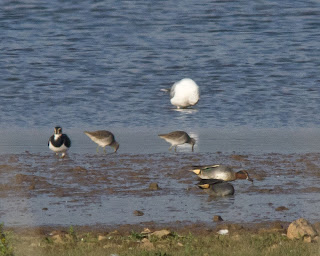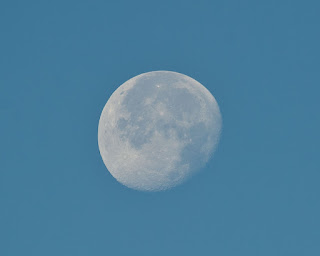With easterly winds at last, birds were pouring into the east coast from the continent on Thursday, and to a lesser extent on Friday. The plan therefor for Saturday seemed pretty well sorted early on, as there were a few decent birds in Suffolk-a putative Isabelline Wheatear, an Isabelline Shrike, a Bluetail and lots of Yellow Browed Warblers, with the promise of more. 50 Short Eared Owls in off the sea at Titchwell on Thursday was interesting. The news of a Rufous Tailed Robin at Warham Greens in Norfolk late on Friday changed everything.
The clear skies did not look good for the bird to stay, so we decided to get to Norfolk fairly late, head for Titchwell and divert to Warham if necessary (also because of the decidedly odd at the time parking instructions).
Driving up the A10 through a fogy fenland landscape, the early news that the bird could not be found was not a great surprise so we carried on with our plan. News of a Red Flanked Bluetail trapped at Holme but not seen since release interesting-I was pretty much expecting a bird to be found today.
We drove through Ringstead and along the backroads to Chosely, finding a nice covey of Grey Partridge. The Moon looked good too.
Further on, a walk around the hedges produced a number of thrushes-my first Fieldfare of the winter, lots of Blackbirds and a few Song Thrushes. Red Legged Partridges, some Curlew and a flyover lapland Bunting added interest. Chosely Barns were rather quieter than last weekend, though some Corn Buntings were found.
As the Bluetail had been seen again, we diverted to Holme. Despite the early hour, the car parks were pretty busy and Bill Boyd was getting overwhelmed issuing permits. We headed off into the pines and searched. A few Brambling and Goldcrests seemed to be it for me, until I noticed that everyone had gone. Rushing back to the access track we found a large crowd watching a single pine where the bird was supposed to have flown too. Despite a long wait there was no sign.
Looking round, I noticed Bill Last, Mike Illet, Daryl Bryant and Barry Reed, so stopped to chat. Obviously they had come up for the Robin first thing and decided to make the best of a bad day with the Bluetail.
We drifted back to the ridge and noticed people moving rapidly-the bird was in the brambles in the dunes. I got glimpses in a small pine as it worked it's way up and then it flew over my head into another bramble clump. It then flew out, and headed west, ironically back to the original lone pine and then another just beyond. I sat down and watched the bush for a bit, seeing a bird fly out and then apparently come back. However it was later relocated in the sycamore and buckthorn by the NWT car park, though few seemed to have seen it, so I returned to the car.
We eventually left and arrived at a full up Titchwell car park. A spell in the Fen Hide failed to locate any Jack Snipe, though I did see a Bittern fly over. Further on in the next hide we watched a huge flock of Golden Plover, many Brents flying in and a rather odd hybrid Wigeon-the head pattern showed a large amount of green on the ear coverts, and a vineous breast more reminiscent of American Wigeon, but everything else, including the head pattern fitted Eurasian.
The sea was rather quiet, as expected due to the light south easterlies, but a small crowd in the dunes drew our attention. I was told a Short Eared Owl had just dropped in. Views in the marram were not brilliant but it was great to see a bird so closely. On the way back, we heard another Lapland Bunting, found around five Rock Pipits on the fresh marsh and watched a pair of Bearded Tits in the reeds.




















































